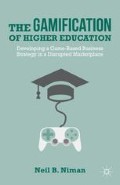Abstract
The foundation of any game lies within what is called the Magic Circle. The Magic Circle defines the space and establishes the binding constraints that will give rise to many of the challenges the player will face. It can be dynamic, but any changes occur in a controlled manner. The rules help to fashion what is possible and what is not. They also provide guidance in terms of how one navigates the various challenges and possible strategies for success. Objects are the parts of the system that take on the form of variables that move, change, or are eliminated as events unfold. Finally, the players move objects according to the rules to generate outcomes. This all culminates in the creation of a game.
Access this chapter
Tax calculation will be finalised at checkout
Purchases are for personal use only
Preview
Unable to display preview. Download preview PDF.
Notes
For a discussion of how technology is affecting the concept of Friendship, see Amichai-Hamburger, Yair, Mila Kingsbury, and Barry H. Schneider. 2013. “Friendship: An Old Concept with a New Meaning?” Computers in Human Behavior 29: 33–39.
Smartphone usage has now exceeded 50 percent of the population. How college students use their smartphones can be found at: Laird, Sam. “In a Relationship: College Students and their Smartphones.” Mashable. Last modified June 30, 2012, http://mashable.com/2012/06/30/smartphones-college-students-infographic/.
See Antheunis, Marjolijn L., Patti M. Valkenburg, and Jochen Peter. 2010. “Getting Acquainted through Social Network Sites: Testing a Model of Online Uncertainty Reduction and Social Attraction.” Computers in Human Behavior 26: 100–109.
Individuals generally have a harder time having meaningful conversations when a mobile phone is present. Przybylski, Andrew K. and Netta Weinstein. 2013. “Can You Connect with Me Now? How the Presence of Mobile Communication Technology Influences Face-toFace Conversation Quality.” Journal of Social and Personal Relationships 30 (3): 237–246.
The problem is exacerbated with the use of technologies such as Snapchat where the pictures self-destruct. Gillette, Felix. 2013. “Snapchat and the Erasable Future of Social Media.” Bloomberg Businessweek February 7. Accessed January 5, 2014, http://www.businessweek.com/articles/2013-02-07/snapchat-and-the-erasable-future-ofsocial-media.
For a discussion of the importance of context in the construction of life stories, see Gregg, Gary S. 1991. Self-Representation: Life Narrative Studies in Identity and Ideology. New York: Greenwood Press.
In a perceptive article about the future of ESPN (the sports network), Douglas Warshaw observed that “most of us are far more interested in capturing the moment than truly experiencing it. It’s no longer about being at the event, as much as it’s about showing the world that you were at the event.” Warshaw, Douglas A. 2013. “Nate Silver, Data, and Storytelling.” CNN Money July 24. Accessed on September 10, 2013, http://features.blogs.fortune.cnn.com/2013/07/24/nate-silver-data-and-storytelling/.
The role of Facebook in building social capital is explored in Steinfield, Charles, Nicole B. Ellison, and Cliff Lampe. 2008. “Social Capital, Self-Esteem, and Use of Online Social Network Sites: A Longitudinal Analysis.” Journal of Applied Developmental Psychology 29 (6): 434–445.
Facebook as a means for improving self-esteem is developed in Gonzales, Amy L. and Jeffrey T. Hancock. 2011. “Mirror, Mirror on My Facebook Wall: Effects of Exposure to Facebook on Self-Esteem.” Cyberpsychology, Behavior, and Social Networking 14 (1–2): 79–83.
The potential impact of information technology on identity is discussed by Nach, Hamid and Albert Lejeune. 2010. “Coping with Information Technology Challenges to Identity: A Theoretical Framework.” Computers in Human Behavior 26: 618–629.
It may be because 69 percent of freshman believe that they are in the top 10 percent or above average and hence there is little need to study very much. Pryor, John H., Kevin Eagan, Laura Paluki Blake, Sylvia Hurtado, Jennifer Berdan, and Matthew H. Case. 2012. The American Freshman: National Norms Fall 2012. Los Angeles: Higher Education Research Institute, 42.
Kahneman, Daniel. 2011. Thinking, Fast and Slow. New York: Farrar, Straus and Giroux.
A general introduction to time discounting and time preference can be found in Frederick, Shane, George Loewenstein, and Ted O’Donoghue. 2002. “Time Discounting and Time Preference: A Critical Review.” Journal of Economic Literature 40 (2): 351–401.
For an accessible introduction to some of the anomalies that exist when making intertemporal choices, see Loewenstein, George and Richard H. Thaler. 1989. “Intertemporal Choice.” Journal of Economic Perspectives 3 (4): 181–193.
For an extended discussion of how students “game” the system, see Johnson, Valen E. 2003. Grade Inflation: A Crisis in College Education. New York: Springer-Verlag.
Walstad, William and Sam Allgood. 1999. “What Do College Seniors Know about Economics?” American Economic Review 89 (2): 350–354.
One student’s experience at Harvard is detailed in “The Truth about Harvard.” Of particular note is one professor’s system of dual grades: a grade that reflects a student’s actual performance and the other grade that appears on their transcript. Douthat, Ross. 2005. “The Truth about Harvard.” The Atlantic March. Accessed on December 22, 2013, http://www.theatlantic.com/magazine/archive/2005/03/the-truth-about-harvard/303726/.
The use of benchmarks to develop best practices is a common practice in business. The strategic use of benchmarks is discussed in Boxwell, Robert J. 1994. Benchmarking for Competitive Advantage. New York: McGraw Hill.
Copyright information
© 2014 Neil B. Niman
About this chapter
Cite this chapter
Niman, N.B. (2014). The Future of Higher Education. In: The Gamification of Higher Education. Palgrave Macmillan, New York. https://doi.org/10.1057/9781137331465_10
Download citation
DOI: https://doi.org/10.1057/9781137331465_10
Publisher Name: Palgrave Macmillan, New York
Print ISBN: 978-1-349-46412-8
Online ISBN: 978-1-137-33146-5
eBook Packages: Palgrave Business & Management CollectionBusiness and Management (R0)

